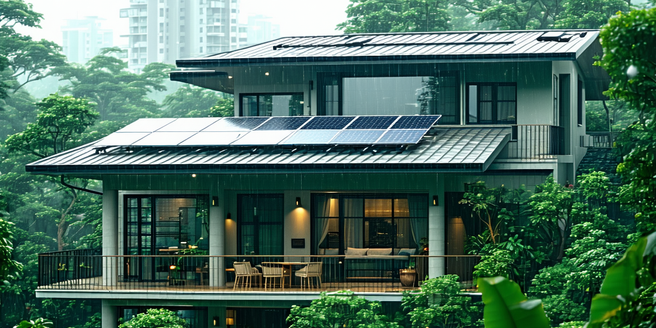Sustainable Housing Projects

Understanding Sustainable Housing: Key Concepts
Sustainable housing refers to the design, construction, and the efficient use of resources in residential buildings to minimize impact on the environment. Key concepts include energy efficiency, water conservation, and the use of sustainable materials. Energy efficiency is achieved through thoughtful architectural design that maximizes natural light and ventilation. Water conservation is crucial, often realized through rainwater harvesting systems and low-flow plumbing fixtures. Materials are chosen for their low environmental impact, often being recycled or renewable. The aim is to reduce carbon footprints and promote healthier living environments. Additionally, community planning plays a critical role ensuring access to public transportation and amenities, reducing the need for vehicular commutes. Understanding these concepts is vital for fostering sustainable communities that can thrive environmentally, economically, and socially.
Innovative Materials and Technologies in Sustainable Housing
Sustainable housing is evolving with groundbreaking materials and technologies aimed at minimizing environmental impacts. One notable advancement is the use of cross-laminated timber (CLT), which offers a low-carbon alternative to steel and concrete, providing strength while reducing emissions. Insulation technology has also surged forward, with materials like aerogel and vacuum-insulated panels offering superior thermal efficiency. Solar photovoltaic systems have become increasingly affordable, allowing more homes to harness renewable energy. Smart home technologies are playing a pivotal role, enabling efficient energy management through automated lighting, heating, and cooling systems. Green rooftops and living walls contribute to biodiversity and aid in insulating buildings naturally. These innovative materials and technologies reflect a broader shift towards sustainable practices, promoting not only environmentally-friendly living but also significant operational cost reductions for homeowners.
Successful Case Studies from Around the World
Numerous successful sustainable housing projects across the globe serve as models for eco-friendly living. In Freiburg, Germany, the Vauban neighborhood is famous for its car-free streets and energy-efficient homes. All residences meet or exceed low-energy building standards, and solar panels are commonplace. In the United States, the BedZED project in London stands out as the largest carbon-neutral eco-community, incorporating recycled materials and focusing on renewable energy sources. In Sweden, Stockholm’s Hammarby Sjöstad development has become a standard-bearer for integrated urban development, employing closed-loop systems that manage water, waste, and energy efficiently. These case studies exemplify the practicality and efficiency of sustainable housing designs and practices, providing critical insights and benchmarks for similar initiatives around the world, and proving that sustainable living is not only achievable but also enhances quality of life.
Economic Benefits of Sustainable Housing Projects
Sustainable housing projects offer numerous economic benefits, proving attractive to both developers and homeowners. By integrating energy-efficient features, these houses significantly reduce utility costs. Renewable energy installations, such as solar panels, contribute to generating home-based power, decreasing reliance on conventional energy sources. Over time, savings on energy bills can offset initial construction costs. Sustainable developments also tend to have higher resale values due to growing demand for eco-friendly living spaces. Moreover, governmental incentives and tax breaks for sustainable construction can further reduce expenses for developers. Additionally, sustainable housing often attracts investment due to its alignment with corporate social responsibility goals. These economic incentives, combined with long-term savings and profitability, underscore the financial viability of sustainable housing projects, supporting the broader adoption of environmentally responsible building practices across global real estate markets.
Challenges and Solutions in Implementing Sustainable Housing
Implementing sustainable housing faces multiple challenges, including higher upfront costs, limited public awareness, and regulatory hurdles. However, solutions are emerging to address these barriers. Financial institutions are recognizing the value of sustainable projects and offer green loans and incentives to offset initial expenses. Raising public awareness through education and demonstration projects is crucial for building demand and understanding of sustainable living benefits. Moreover, collaboration between stakeholders, including governments, developers, and communities, is pivotal in streamlining regulatory processes and ensuring that policies support sustainable practices. Technological advancements are also aiding the transition by lowering costs of eco-friendly technologies and materials. By addressing these challenges collaboratively, sustainable housing can become a mainstream reality, paving the way for more environmentally friendly construction practices that benefit both the economy and the planet.
The Future of Sustainable Housing: Trends and Predictions
The future of sustainable housing is dynamic and promising, with emerging trends focused on resilience and innovation. Prefabricated housing, which reduces waste and construction time, is gaining popularity. Technologies like 3D printing are revolutionizing construction, allowing for efficient use of materials and swift building processes. Smart home systems continue to evolve, providing homeowners with precise control over energy usage and resource management. The focus on net-zero energy homes, which produce as much energy as they use, is also intensifying. With greater emphasis on climate-resilient structures, the incorporation of flood defenses and heat-resistant designs is becoming standard in new projects. Predictions indicate that sustainable housing will increasingly integrate urban agriculture and community-shared resources, transforming residential areas into vibrant, self-sufficient ecosystems. This evolution demonstrates an unyielding commitment to environmental stewardship and innovation in the housing sector.